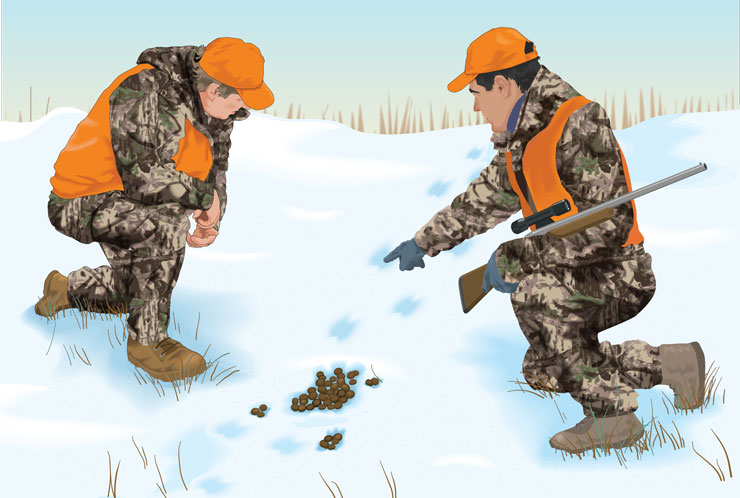
So, you’re planning on going hunting? That’s exciting! But before you head out into the great outdoors, there are a few things you should know about the animal you’re hunting. Knowing the ins and outs of your target can make a huge difference in your hunting success and ensure a safe and ethical hunt.
First and foremost, it’s important to familiarize yourself with the specific habits, behaviors, and patterns of the animal you plan to hunt. This includes understanding their preferred habitats, feeding patterns, and mating rituals. The more you know about their natural behavior, the better equipped you’ll be to anticipate their movements and increase your chances of a successful hunt.
Another crucial aspect to consider is the animal’s physical characteristics and anatomy. Understanding the anatomy of your target species can help you identify vital organs and make accurate shots. Additionally, being aware of any special adaptations or defensive mechanisms they possess can help you stay safe during your hunt.
Lastly, you should research any specific regulations or laws regarding the hunting of the animal you’re targeting. Different species may have different hunting seasons, bag limits, or weapon restrictions, so it’s essential to stay up-to-date on the current regulations. By adhering to these rules, you not only contribute to conservation efforts but also ensure the longevity of the hunting activity for future generations.
In our upcoming article, we’ll delve deeper into these aspects and provide you with more detailed information on what you need to know about the animal you’re hunting. So, stay tuned and get ready to boost your hunting game by becoming a well-informed hunter!

CLICK HERE FOR THE BESTSELLING HUNTING GEAR
What Must You Know About The Animal You Are Hunting?
Hunting is a popular recreational activity enjoyed by people all over the world. Whether for sport or sustenance, hunting requires a deep understanding of the animal being pursued. Knowing about the animal’s behavior, physical characteristics, movement, senses, diet, social structure, predators or prey, vulnerabilities, and legal regulations and hunting ethics plays a crucial role in becoming a skilled and responsible hunter. This article aims to guide you through the essential knowledge you need to possess before embarking on your hunting expedition.
Understanding the Animal’s Behavior
Identifying the Animal’s Natural Habitat
To increase your chances of a successful hunt, it is vital to identify the animal’s natural habitat. Understanding where the animal lives provides valuable insight into its behavior, feeding patterns, and movement. Research their preferred ecosystems, such as forests, grasslands, or wetlands, as well as specific types of terrain within these habitats. By familiarizing yourself with their natural environment, you can effectively plan your hunting strategies.
Studying the Animal’s Feeding Patterns
A thorough understanding of the animal’s feeding patterns is essential to track and locate them. Research their preferred food sources, whether it be vegetation, small mammals, or insects. Knowing when and where the animal feeds can help you anticipate its movements and increase your chances of encountering it during hunting season.
Observing the Animal’s Mating Behaviors
Understanding the animal’s mating behaviors is crucial for successful hunts during the mating season. Research their courtship rituals and behaviors to identify signs that indicate their presence. Learning about their mating calls, behaviors, and territorial displays helps you determine their location and increase your chances of encountering them. This knowledge allows you to time your hunting expeditions effectively.
Recognizing the Animal’s Territorial Tendencies
Many animals exhibit territorial tendencies, defending their space from intruders. Learning about the animal’s territorial instincts enables you to identify areas where they are likely to be found. Researching their scent marking habits, signs of aggression, and territorial boundaries helps you understand their behavior and strategize your hunting plans accordingly.
CLICK HERE FOR THE BESTSELLING HUNTING GEAR
Researching the Animal’s Physical Characteristics
Learning About the Animal’s Size and Weight
Familiarizing yourself with the animal’s size and weight provides valuable information for hunting. Knowing the average dimensions of the animal allows you to gauge its age and determine if it meets legal requirements for harvest. Additionally, understanding the animal’s size helps you anticipate its mobility and behavior in different terrains.
Examining the Animal’s Coloration and Markings
Distinctive coloration and markings can aid in identifying the animal during hunting trips. Research the animal’s specific patterns, hues, and markings to differentiate it from similar species. Understanding their camouflage mechanisms can prevent mistaking non-target animals for your intended quarry.
Understanding the Animal’s Physical Adaptations
Animals have evolved various physical adaptations that affect their behavior and survival. Researching the animal’s physical adaptations, such as keen senses, speed, strength, and agility, helps you gauge their capabilities and reaction times. This knowledge allows you to tailor your hunting techniques and approach accordingly.
Identifying the Animal’s Unique Features
Every animal possesses unique features that set it apart from others. Discover the distinguishing characteristics, such as horns, antlers, fangs, or distinctive body parts unique to the animal species you are hunting. By identifying these features, you can quickly recognize your target and avoid unintentionally targeting a protected or endangered species.
Gauging the Animal’s Movement and Speed
Analyzing the Animal’s Locomotion Style
Understanding the animal’s locomotion style provides valuable insight into its movement patterns and behavior. Research whether the animal primarily walks, runs, jumps, swims, or flies. This knowledge helps you anticipate their movements and position yourself for a successful hunt.
Estimating the Animal’s Running Speed
Knowing the animal’s running speed is essential for planning your approach and ensuring a successful hunt. Research their average speed and burst speed to determine if they can outrun you or other potential predators. This information allows you to strategize your positioning and select appropriate hunting methods.
Understanding the Animal’s Agility and Maneuverability
Animals differ in their agility and maneuverability, impacting their ability to evade predators or hunters. Research their agility, climbing skills, and maneuverability in various types of terrain. Understanding their limitations and strengths can increase your chances of a successful hunt.
Assessing the Animal’s Jumping or Flying Abilities
Some animals possess exceptional jumping or flying abilities, which affect their mobility and vulnerability. Research whether the animal is a skilled jumper or flyer and how it utilizes these abilities in its habitat. This knowledge helps you anticipate their escape routes and modify your hunting strategies accordingly.

Knowing the Animal’s Senses and Awareness
Exploring the Animal’s Keen Sense of Smell
Animals rely heavily on their sense of smell to detect predators or approaching hunters. Research the animal’s sense of smell and how they utilize it for survival. Understanding their olfactory capabilities allows you to employ scent control techniques to minimize your presence and increase your chances of a successful hunt.
Understanding the Animal’s Vision Capabilities
Different animals have varying degrees of visual acuity. Research their visual capabilities, such as color perception, depth perception, and field of view. Knowing their visual limitations helps you modify your camouflage techniques and approach to avoid detection during hunts.
Recognizing the Animal’s Acute Hearing
The animal’s acute hearing is another critical factor to consider while hunting. Understanding their hearing range, sensitivity, and ability to localize sounds help you minimize noise and movement during your pursuit. Researching their hearing mechanisms allows you to plan silent approaches, increasing your chances of a successful hunt.
Assessing the Animal’s Awareness of Its Surroundings
Animals are highly attuned to their surroundings and react swiftly to any disruptions. Research their awareness behavior, such as scanning behaviors, micro-movements, and alertness levels. Understanding their level of awareness enables you to blend seamlessly into the environment and avoid triggering their defensive responses.
Studying the Animal’s Diet and Feeding Habits
Researching the Animal’s Preferred Food Sources
Understanding the animal’s preferred food sources is crucial for locating their habitats and predicting their movement patterns. Research the specific vegetation, small mammals, insects, or other food sources they rely on. This knowledge allows you to scout areas with abundant food supplies, increasing your chances of a successful hunt.
Identifying the Animal’s Feeding Methods
Animals employ various feeding methods based on their physical adaptations and habitats. Research whether the animal grazes, browses, scavenges, or actively hunts for their food. Understanding their feeding methods helps you anticipate their behavior and choose appropriate hunting techniques.
Understanding the Animal’s Hunting or Foraging Strategies
Predatory animals have unique hunting strategies that affect their behavior and vulnerability. Research their hunting methods, such as stalking, ambushing, or scavenging, to identify potential hunting grounds and increase your chances of success. By emulating their techniques, you can improve your hunting skills.
Learning About the Animal’s Seasonal Food Preferences
Animals may alter their food preferences based on seasonal availability. Research their shifting dietary preferences throughout the year to identify seasonal habits and patterns. Understanding their food preferences during specific times of the year helps you plan your hunts accordingly.

Understanding the Animal’s Social Structure
Exploring the Animal’s Hierarchy Within Its Group
Many animals exhibit a hierarchical social structure within their groups. Research the social dynamics, such as dominant individuals, the pecking order, or family units within the species you intend to hunt. Understanding their social hierarchy prepares you for potential encounters and enables you to anticipate their behavior.
Studying the Animal’s Communication Methods
Animals communicate through a variety of methods, including vocalizations, body language, or chemical signals. Research their communication methods to decipher cues and signals indicating the presence of other animals or potential threats. This knowledge allows you to interpret their behaviors accurately during hunting trips.
Recognizing the Animal’s Social Behaviors
Animals display various social behaviors within their groups, such as grooming, playing, or territorial disputes. Research these behaviors to understand their social interactions, cooperative efforts, and means of communication. Recognizing their social behaviors enhances your ability to locate and approach your target during hunts.
Understanding the Animal’s Mating Rituals
Understanding the animal’s mating rituals is crucial for successful hunts during the breeding season. Research their courtship displays, vocalizations, or territorial behaviors that indicate their readiness to mate. This knowledge allows you to identify mating grounds and increase your chances of encountering the animal during this period.
Identifying Potential Predators or Prey of the Animal
Researching the Animal’s Natural Enemies
Knowing the animal’s natural enemies provides insight into their behavior and vulnerabilities. Research the predators that pose a threat to the animal you are hunting. Understanding their natural enemies allows you to anticipate their defensive strategies and modify your approach accordingly.
Recognizing the Animal’s Defensive Mechanisms
Animals employ various defensive mechanisms in response to predators or threats. Research their defensive behaviors, such as running, hiding, or fighting, to understand their means of protecting themselves. This knowledge helps you plan your hunting techniques while minimizing the risk of injury.
Identifying the Animal’s Prey Species
Understanding the animal’s prey species is vital for establishing their position in the food chain and potential hunting grounds. Research the animals or organisms the species you are hunting preys upon. Identifying their prey species helps you locate hunting areas with abundant food supplies and suitable habitats.
Understanding the Animal’s Hunting Techniques
Predatory animals employ specific hunting techniques in pursuit of their prey. Research their hunting methods, such as ambush, pursuit, or cooperative hunting, to understand their strategies. This knowledge enables you to anticipate their movements and adjust your hunting approach accordingly.
Evaluating the Animal’s Vulnerabilities
Assessing the Animal’s Weaknesses
Understanding the animal’s weaknesses allows you to exploit their vulnerabilities during hunts. Research their limitations, such as stamina, vulnerability to certain weather conditions, or susceptibility to specific diseases. This knowledge helps you plan your hunts strategically and increases the chances of a successful harvest.
Understanding the Animal’s Response to Threats
Animals exhibit various responses to threats or perceived dangers. Research their fight, flight, or freeze responses to gauge their reactions in different situations. Understanding their responses enables you to modify your hunting techniques and ensure a safe and ethical pursuit.
Recognizing the Animal’s Fear-Inducing Factors
Animals have fear-inducing factors that trigger their defensive behaviors. Research the stimuli that instigate fear or panic, such as loud noises, sudden movements, or specific scents. Recognizing these factors helps you minimize disturbances during your hunts and avoid alerting the animal to your presence.
Identifying the Animal’s Vulnerable Age Groups
Different age groups within the animal population may exhibit varying levels of vulnerability. Research the vulnerable age groups, such as juveniles or elderly individuals, to ensure ethical and responsible hunting practices. Identifying vulnerable age groups allows you to target mature individuals while safeguarding the sustainability of the species.
Knowing Legal Regulations and Hunting Ethics
Researching Local Hunting Laws and Regulations
Before embarking on any hunting expedition, it is essential to research and understand the local hunting laws and regulations. Familiarize yourself with the hunting seasons, bag limits, licensing requirements, and prohibited hunting areas. Complying with these regulations ensures ethical and legal hunting practices.
Understanding Ethical Hunting Practices
Ethical hunting promotes sustainable wildlife management and conservation. Educate yourself on the principles of fair chase, which advocate for respecting the animal, minimizing suffering, and honoring the environment. Upholding ethical hunting practices ensures the preservation of wildlife populations for future generations.
Recognizing Protected Species and Seasons
Certain animal species may be protected or restricted from hunting due to conservation concerns. Research the protected species in your region and familiarize yourself with their characteristics to avoid targeting them unintentionally. Additionally, understand the designated seasons for hunting specific animals, respecting the need for reproductive periods and migration patterns.
Abiding by Hunting Licensing Requirements
Acquiring the necessary hunting licenses and permits is essential for legal and responsible hunting. Research the requirements specific to your region and obtain the appropriate licenses. Complying with licensing regulations showcases your commitment to responsible hunting practices and contributes to wildlife conservation efforts.

Conclusion
Taking the time to learn about the animal you are hunting enhances your hunting experience in numerous ways. Understanding their behavior, physical characteristics, movement, senses, diet, social structure, predators or prey, vulnerabilities, and legal regulations and hunting ethics not only increases your chances of a successful hunt but also contributes to sustainable hunting practices. Applying this knowledge allows you to hunt responsibly, ethically, and with respect for the animals and their habitats. By becoming a knowledgeable and skilled hunter, you contribute to the preservation and conservation of wildlife populations, ensuring their existence for future generations of hunters to appreciate and enjoy.


